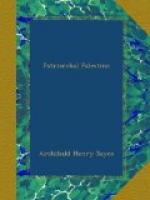Besides the names of Jacob-el and Joseph-el, Mr. Pinches has met with other distinctively Hebrew names, like Abdiel, in deeds drawn up in the time of the dynasty to which Khammurabi belonged. There were therefore Hebrews—or at least a Hebrew-speaking population—living in Babylonia at the period to which the Old Testament assigns the lifetime of Abraham. But this is not all. As I pointed out five years ago, the name of Khammurabi himself, like those of the rest of the dynasty of which he was a member, are not Babylonian but South Arabian. The words with which they are compounded, and the divine names which they contain, do not belong to the Assyrian and Babylonian language, and there is a cuneiform tablet in which they are given with their Assyrian translations. The dynasty must have had close relations with South Arabia. This, however, is not the most interesting part of the matter. The names are not South Arabian only, they are Hebrew as well. That of Khammu-rabi, for instance, is compounded with the name of the god ’Am, which is written ’Ammi in the name of his descendant Ammi-zaduqa, and ’Am or ’Ammi characterizes not only South Arabia, but the Hebrew-speaking lands as well. We need only mention names like Ammi-nadab or Ben-Ammi in illustration of the fact. Equally Hebrew and South Arabian is zaduqa or zadoq; but it was a word unknown to the Assyrian language of Babylonia.
When Abraham therefore was born in Ur of the Chaldees, a dynasty was ruling there which was not of Babylonian origin, but belonged to a race which was at once Hebrew and South Arabian. The contract tablets prove that a population with similar characteristics was living under them in the country. Could there be a more remarkable confirmation of the statements which we find in the tenth chapter of Genesis? There we read that “unto Eber were born two sons: the name of the one was Peleg,” the ancestor of the Hebrews, while the name of the other was Joktan, the ancestor of the tribes of South Arabia. The parallelism between the Biblical account and the latest discovery of archaeological science is thus complete, and makes it impossible to believe that the Biblical narrative would have been compiled in Palestine at the late date to which our modern “critics” would assign it. All recollection of the facts embodied in it would then have long passed away.
Even while I write Prof. Hommel is announcing fresh discoveries which bear on the early history of the Book of Genesis. Cuneiform tablets have turned up from which we gather that centuries before the age of Abraham, a king of Ur, Ine-Sin by name, had not only overrun Elam, but had also conquered Simurru, the Zemar of Gen. x. 18, in the land of Phoenicia. A daughter of the same king or of one of his immediate successors, was high-priestess both of Elam and of Markhas or Mer’ash in Northern Syria, while Kimas or Northern Arabia was overrun by the Babylonian arms. Proofs consequently are multiplying of




